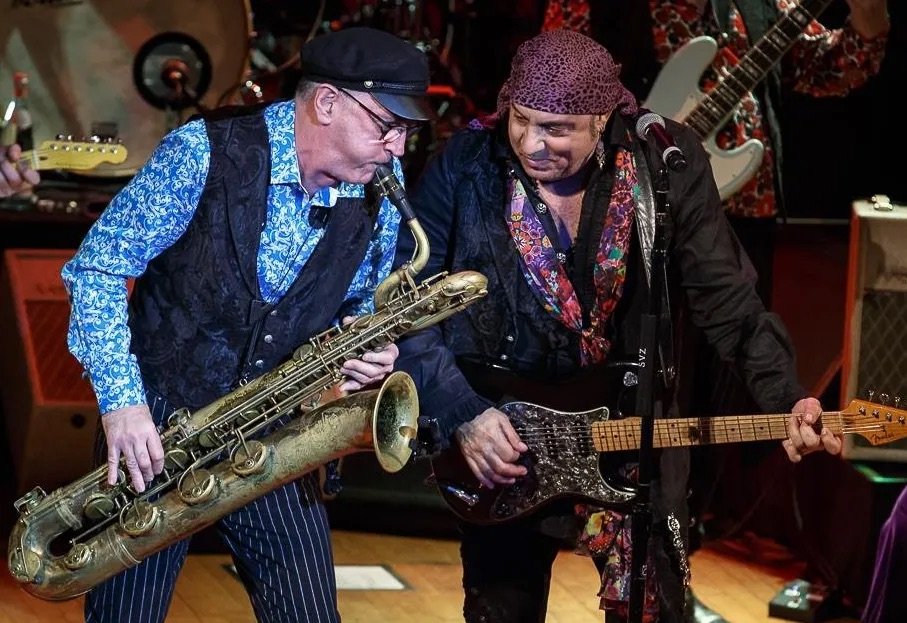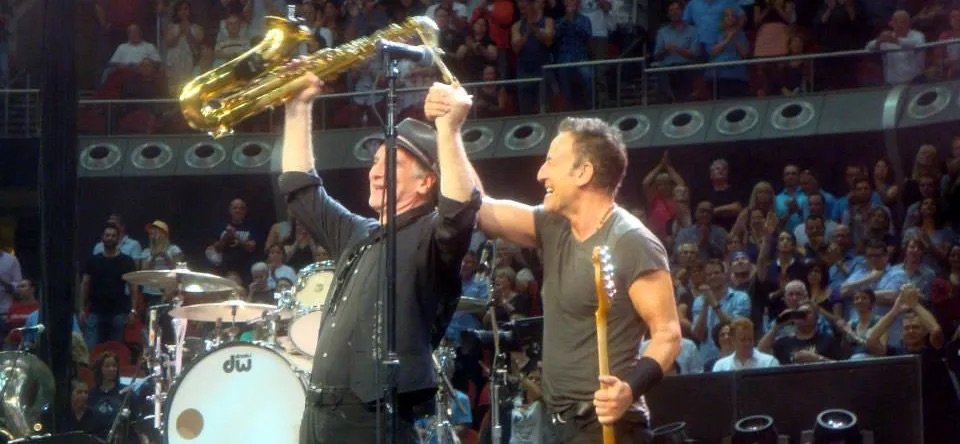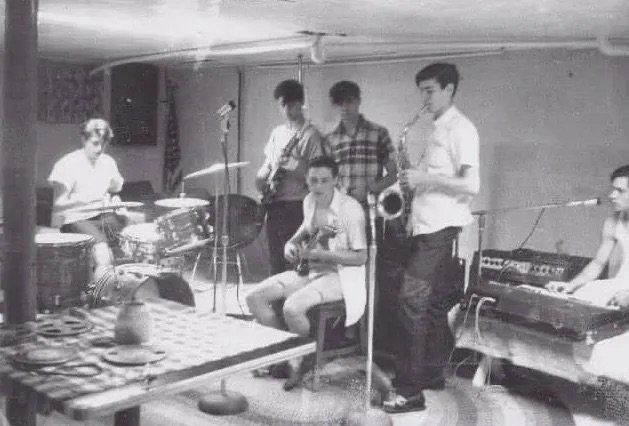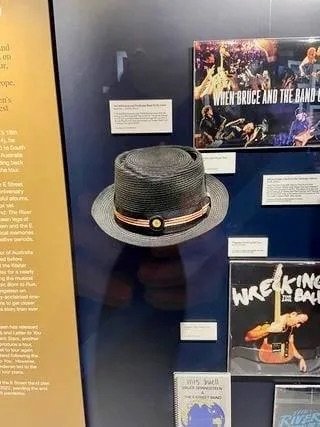Eddie Manion: Sax Man for the Ages
UP CLOSE
⭐️
Eddie Manion
⭐️
UP CLOSE ⭐️ Eddie Manion ⭐️
Coastin’ In, the third solo album of Lakehurst-born Sax-Man-To-The-Stars Eddie Manion, 69, was mixed in Asbury Park after basic tracks were laid down in Long Branch, keyboards, bagpipes, French Horn added in Hoboken, and some cool blues harp added in Mendham.
He’s played for Presidents and Kings. As Horn Director for Little Steven & The Disciples of Soul for the past four years, he certainly had a wealth of talent to choose from to accompany his alternately honking and purring tones.
With a style reminiscent of the late Michael Brecker, he can get funky and syncopated, yet smooth and soulful. His sax is like a human voice and, man, does it sing! His material is sterling, filled to the brim with the kind of melodies that are by now part of the musical DNA of Baby Boomers everywhere.
Mixed by two of his Disciples Of Soul bandmates, Music Director/Guitarist/ Mark Ribler and bassist Jack Daley, Manion strutted his stuff, produced and arranged. (He even wrote and sang one track, “The Lights Are On At Old St. John’s.”)
Lyrical, evocative, you can’t go wrong with Brian Wilson’s 1966 “God Only Knows” (complete with Beach Boys vocal harmony), Steve Winwood’s 1988 “Roll With It” (where he adds a dash of Junior Walker’s 1965 “Roadrunner), Hoagy Carmichael’s 1930 “Georgia On My Mind,” silent film star Charlie Chaplin’s 1936 “Smile,” the 1956 Johnny Mathis hit “When Sunny Gets Blue,” the 1969 Hollies hit “He Ain’t Heavy He’s My Brother” and six more of his favorite songs. Ed Manion proved to be an articulate spokesperson for his craft.
“It’s all true. I worked a lot with Diana Ross. In 1982, I did a world tour in her band with the late conductor Joe Guercio who was Elvis Presley’s orchestra leader.”
Mike Greenblatt: We’re talkin’ to sax man Eddie Manion who—besides being in the bands of Bruce Springsteen, Southside Johnny and Little Steven—has played alongside Paul McCartney, Willy DeVille, Dave Edmunds, Keith Richards, Bob Dylan, Dion, The Allman Brothers, and plenty more.
Eddie Manion: It’s all true. I worked a lot with Diana Ross. In 1982, I did a world tour in her band with the late conductor Joe Guercio who was Elvis Presley’s orchestra leader. I started, though, with Southside Johnny & The Asbury Jukes. I did time with Little Steven & The Disciples of Soul. Before I became his Horn Director, we recorded his 1991 Men Without Women album together. I also joined Robert Cray’s band which I’m pretty proud of. That was some band! They were all musician’s musicians. When I was in the Asbury Jukes with Southside Johnny, for instance, we wouldn’t really meet a lot of other musicians on the road. We’d play, go back to the hotel and travel the next day. With Robert Cray, though, things were different. We were really right in the middle of the blues world where I got to meet so many unbelievable musicians. I remember performing at one of those “Guitar Legends” shows with him in Spain. I was part of a horn section that backed up everybody on the show. Guitarist Steve Cropper was in that band.
MG: You played at The White House for President Clinton!
EM: More than once! It was through Maria Shriver who organized benefits for The Special Olympics. I was in a house band that Jon Bon Jovi put together. Once, during a Christmas show, we backed up Eric Clapton, Sheryl Crow and BB King. So you can add those names too.
MG: You get to meet the President?
EM: Yes we did! I also performed at his first inauguration with a band that E Street drummer Max Weinberg put together. Clarence Clemons was in that band too. I remember the President and the First Lady came out when we played [the 1961 James Brown hit] “Night Train.” I was playing baritone at the time but I had my tenor sax with me as well. So here comes Bill Clinton looking like he wanted to play some sax too so I handed him my tenor and he performed with us. I had figured beforehand that he might so I brought him a mouthpiece but he came with his own. You should have seen the 25 Secret Service men stiffening up all around us when my hand disappeared into my pocket to give him the mouthpiece! I cannot tell you how incredible of a feeling it was to actually jam with the President of the United States!
MG: You also played halftime at the 2009 Super Bowl.
EM: Yes, with Bruce Springsteen & The E Street Band. What a thrill that was!
MG: That particular halftime show was up amongst the greatest Super Bowl halftime shows in history, right up there with Prince in 2007 playing “Purple Rain” in a pouring rain or the Rolling Stones in 2006. No halftime since then has even came close.
EM: It might have been the most exciting 12 minutes of my life, yeah. I had just moved from Jersey to Pittsburgh that year, got married, and absolutely loved the fact that the Pittsburgh Steelers were in the big game that year and wound up winning. I’ll never forget it.
MG: How can you possibly concentrate in such an overwhelming environment?
EM: It was pretty intense. Everything was happening so fast. But you have a job to do so you do it. Playing with Bruce, though, is second nature to me. I can’t tell you how many times I’ve played “Tenth Avenue Freezeout” with him. In 1988 alone, I must’ve played it hundreds of times while on his “Tunnel Of Love” tour. It lasted over a year.
MG: You’ve also recorded with Bruce on no less than six of his albums: Western Stars (2019), High Hopes (2014), Wrecking Ball (2012), The Promise (2010) and my favorite, We Shall Overcome: The Seeger Sessions (2006). You also were there with him for that great 2007 Live In Dublin album.
EM: I can honestly say I was an original member of Bruce Springsteen & The Seeger Sessions Band. It’s one of the things I’m most proud of. It was just a total joy to record that album in the way we recorded it. It was at Bruce’s farmhouse in Rumson. I don’t think I’ve ever seen Bruce Springsteen as happy as he was recording that record. He had a smile on his face from the beginning to the end. It’s a really great album and the process of how we did it, live, in his home studio—not the studio he has now but his first studio—with some of us in his hallway complete with TV monitor of Bruce and the rhythm section in the living room. He would start playing the songs on acoustic guitar and everybody would just fall in. A lot of those songs I had heard as a kid.
MG: It won the Grammy for “Best Traditional Folk Album.”
EM: Yeah, I mean, sure, with songs like “Pay Me My Money Down” [1942], “Erie Canal” [1913], and “Oh Mary Don’t You Weep” [1915].
MG: Now comes Coastin’ In, your third solo album. There was a gap of 11 years between your first and second albums. I hope we won’t have to wait until 2033 for your fourth album!
EM: Well, I was a little busy with other artists. Had to make a living, y’know? My goal now, though, is to record an album every year. To that end, I started my own label, Kingfish Morris Records. (My nickname is Kingfish and I currently live in Morris, PA.) There’ll be a spaceship logo because my music is out of this world! It was pretty much a no-brainer as to who I was going to use on the album. I was very fortunate to be able to tour in ’17, ’18 and ’19 with Little Steven around the world before the pandemic, and record three albums with him.
In fact, I consider myself truly blessed to work extensively in the bands of Bruce, Southside, Little Steven, Robert Cray and Diana Ross. Not only are they all great musicians but they’re all truly good people, focused in on their careers, devoid of drugs and scandal, filled with nothing but music and altruistic endeavors. That’s what makes them great. Take Bruce, for instance. I’ve never met a person so dedicated to his craft. He’s so prolific. Bruce writes every day. I just hope that some of his drive has rubbed off on me. He’s a good role model for any hard-working musician. He’s a stickler for detail. So is Little Steven (although he likes to be called Stevie Van Zandt these days). They spare no expense or any amount of time with production to get it just right. They have the resources to do so. Unfortunately for me, I don’t. But since I learned from those two the most, I find myself in a position where I insist on using the best recording techniques, the top studios and the best sidemen. It’s why I have to take my time. Took me two years to record this record. I pay everybody well. I don’t ask people to work for nothing. That bar was set pretty high for me with Bruce and Little Steven. I saw first-hand how they operate. How could I not do it their way? There’s no cutting corners. I spent a fortune on this record. That’s why it sounds as good as it does.





